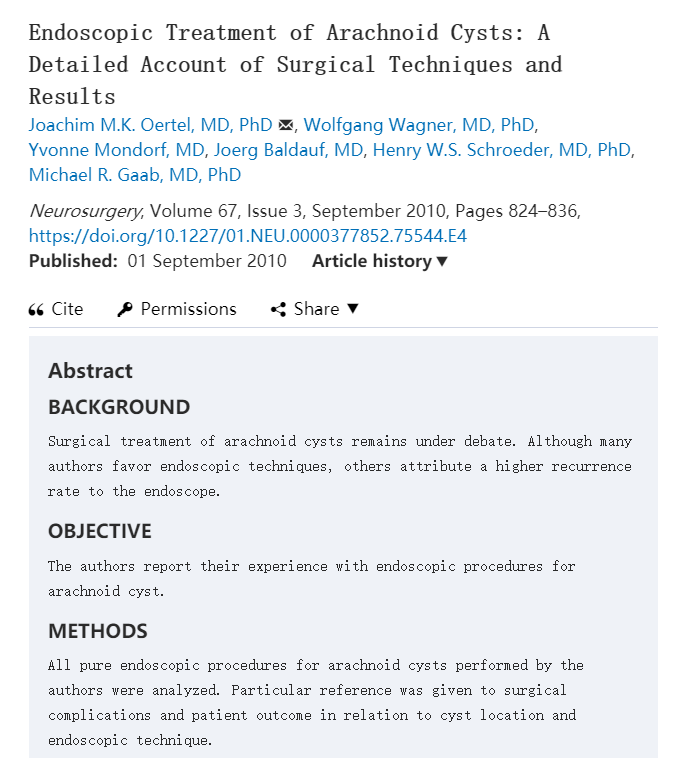Endoscopic Treatment of Arachnoid Cysts: A Detailed Account of Surgical Techniques and Results(蛛网膜囊肿神经内镜治疗:手术技术和结果详细说明)
英文摘要:
BACKGROUND
Surgical treatment of arachnoid cysts remains under debate. Although many authors favor endoscopic techniques, others attribute a higher recurrence rate to the endoscope.
OBJECTIVE
The authors report their experience with endoscopic procedures for arachnoid cyst.
METHODS
All pure endoscopic procedures for arachnoid cysts performed by the authors were analyzed. Particular reference was given to surgical complications and patient outcome in relation to cyst location and endoscopic technique.
RESULTS
Sixty-six endoscopic procedures were performed in 61 patients (mean age, 28 years; range, 23 days to 74 years; 35 males, 26 females). The main presenting symptoms were cephalgia (61%), hemisymptoms (18%), and macrocephalus (18%). Cyst location was temporobasal (34%), suprasellar (21%), at the cisterna quadrigemina (18%), paraxial supratentorial (16%), and various (10%). Thirty cystocisternostomies, 14 ventriculocystostomies, 12 cystoventriculostomies, and 10 ventriculocystocisternostomies were performed. The overall clinical success rate was 90%. The endoscopic technique was abandoned in 4 cases (7%). Postoperative complications were found in 16%; there was only one permanent deficit (2%). Five recurrences (8%) occurred up to 7 years after the first procedure. Of the various locations, the temporobasal cysts were the most difficult to treat with lowest clinical success (81%), highest recurrence (19%), and highest complication rate (24%). Of the various endoscopic techniques, ventriculocystostomy and ventriculocystocisternostomy reached the highest success rates with 全切.
CONCLUSIONS
Endoscopic techniques provide very good results in arachnoid cyst treatment. The most frequent cyst location is the most difficult to treat. A long-term follow-up is recommended since recurrences can occur many years after the procedure.
中文摘要:
蛛网膜囊肿的手术治疗仍在争论中。尽管许多作者赞成内窥镜技术,但其他人则认为内窥镜具有较高的复发率。
目的
作者报告了他们在蛛网膜囊肿的内窥镜检查程序方面的经验。
方法
作者对蛛网膜囊肿的全部纯内窥镜检查程序进行了分析。特别参考了与囊肿位置和内窥镜检查技术有关的手术并发症和患者预后。
结果
61例患者接受了66例内窥镜检查(平均年龄28岁;范围23天至74岁;男35例,女26例)。主要表现为头痛(61%),偏头痛(18%)和大头颅(18%)。囊肿的位置是颞颞叶(34%),鞍上(21%),四边形水罐(18%),旁轴上上肌(16%)和各种(10%)。进行了30例膀胱切除术,14例脑室膀胱切开术,12例膀胱脑室切开术和10例脑室膀胱切开术。总体临床成功率为90%。内镜技术被放弃4例(7%)。术后并发症发生率为16%。只有一个长期性赤字(2%)。一开始手术后的7年内发生了5次复发(8%)。在各个地方,颞叶囊肿是较难治疗的,临床成功率较低(81%),复发率较高(19%),并发症发生率较高(24%)。在各种内窥镜检查技术中,脑室膀胱造口术和脑室囊尾囊切除术的成功率较高,均为100%。
结论
内窥镜技术在蛛网膜囊肿治疗中提供了好的结果。比较常见的囊肿位置是较难治疗的。建议进行长期随访,因为术后多年可能会复发。

该论文的写作者之一Henry W.S. Schroeder教授为INC国际神经外科医生集团旗下国际神经外科顾问团(WANG)成员,他也是国际神经内镜联合会执行委员会主席、国际神经外科学会联合会(WFNS)内镜委员会前主席、德国格赖夫斯瓦尔德大学(Greifswald University)神经外科教授兼主席。




